Transitioning Your Cat to a Raw Diet: A Step-by-Step Guide

At Raw Essentials, we are dedicated to providing the best in feline nutrition through our high-quality raw food. As experts in cat nutrition, we understand that transitioning your cat to a raw diet is a significant step towards enhancing their overall health and vitality. Here’s our guide to making the transition smooth and successful.
Step Away from the Biscuits
To ensure optimal digestion and nutrient absorption, it’s crucial to eliminate processed foods from your cat’s diet. Processed foods, including kibble, treats with additives, preservatives, and grains like potatoes, starches, wheat, corn, rice, and soy, can disrupt your cat’s digestive system and hinder their ability to fully benefit from raw food. Transitioning away from these processed options will help your cat’s body adapt more smoothly to their new, wholesome diet. It's best to only start on raw food once you have made sure any kibble is out of the house (finish this before starting).
Establish a Feeding Routine
Before introducing your cat to their new raw diet, it’s essential to establish a consistent feeding routine. If your cat is accustomed to grazing on kibble or other processed throughout the day, transitioning to set meal times will help regulate their feeding habits and develop a hunger. Begin by setting specific meal times for their current food, which will make it easier to introduce raw food later on. Put their food down at two set mealtimes per day and once your cat is eating their regular food at consistent times, you are ready to start introducing Raw Essential's food.
Introducing Raw Food
The general approach to transitioning cats to a raw diet is to take the cold turkey approach stop feeding what you are currently feeding one day. And the next day, introduce Raw Essentials food. To ensure food safety, place the raw meal down for your cat and allow them up to an hour to eat it. If they don’t finish within that time frame, pick up the uneaten portion and refrigerate it to prevent spoilage. This approach supports a smooth transition as well as maintaining high standards of hygiene and food safety for your pet.
Choose Prey Sources They Love
Start by selecting protein or prey sources that your cat is already familiar with and enjoys. For example, if your cat enjoys chicken or fish flavoured kibble or wet food, use these proteins as a foundation for their new diet. These familiar flavour and scents can ease the transition and help your cat adjust to the new texture and taste of raw food. By leveraging your cat's existing preferences, you can make the shift to a raw diet both enjoyable and beneficial for your feline friend.
Consider Environmental Factors
Cats’ appetites can fluctuate with seasonal changes, often eating more in winter and less in summer. Additionally, they may seek out other food sources through hunting or scavenging. Be mindful of these factors and adjust the quantity of raw food accordingly to match their appetite and other environmental influences.
Variety is Key
A varied diet is vital for providing a comprehensive range of nutrients. We recommend offering meat, bones, organs, and tripe from a variety of different prey species. To ensure your cat receives a balanced diet, we recommend feeding at least three different prey species over the course of a week. This variety helps cover all the essential nutrients needed to supports your cat’s dietary requirements.
Serve at Room Temperature
Cats are natural hunters and in the wild, their prey is consumed warm. To mimic this natural feeding behavior, serve your Raw Essentials food at room temperature. This can make the food more appealing and enjoyable for your cat, enhancing their dining experience and easing the transition to their new diet.
Suitable Treats for Raw-Fed Felines
Treats can be an excellent way to reward and bond with your cat. Opt for raw, high-quality treats such as our Raw Essentials Freeze-Dried Lamb Green Tripe, Freeze Dried Chicken Bites, Freeze Dried Veal & Heart Bites, and Freeze Dried King Salmon. Avoid processed treats containing grains and additives, as they can interfere with your cats digetion and make it hard for them to gain the full benefits of a raw diet.
Introducing New Raw Mixes
When introducing a new raw mix to your cats mealtimes it is important to do so gradually. Start by mixing a small amount of the new raw mix with the raw mix they are already accustomed to eating and gradually increase the proportion of the new mix over time. This gradual transition helps your cat adjust to new flavors and textures and makes them more likely to be open to trying a variety of prey sources and products.
Converting Biscuit-Addicted Cats
For cats who are particularly addicted to kibble, it can be beneficial to first transition them to a diet of wet food before introducing raw. Wet food has a similar texture to raw food and can ease the transition process. Once your cat is consistently eating wet food at set mealtimes, you can start introducing Raw Essentials, making the switch more manageable. Read further information about converting biscuit addicted cats here.
Final Thoughts
Transitioning your cat to a raw diet is a rewarding journey that can lead to improved health, vitality, and overall well-being. At Raw Essentials, our team of trained nutrition advisors are here to support you every step of the way with expert advice and high-quality raw food products designed to meet your cat’s nutritional needs.
By following these expert tips, you can ensure a smooth shift to a raw diet and provide your cat with the optimal nutrition they deserve. For more information or personalized guidance, don’t hesitate to reach out to our knowledgeable team. Together, let’s embark on this journey towards a healthier, happier life for your cat.

